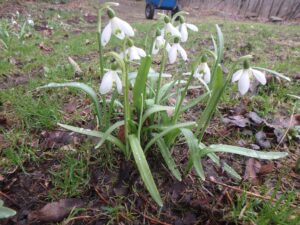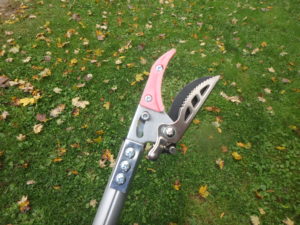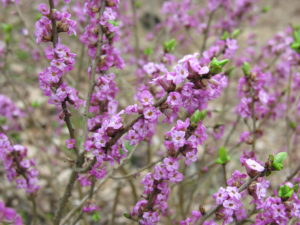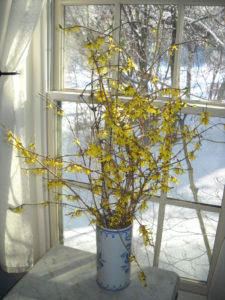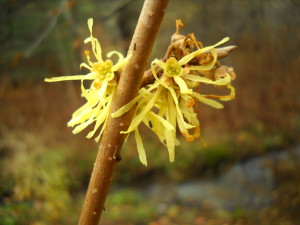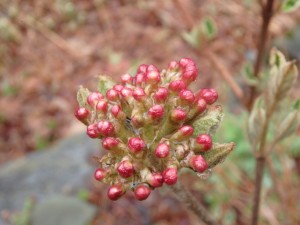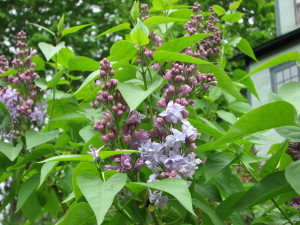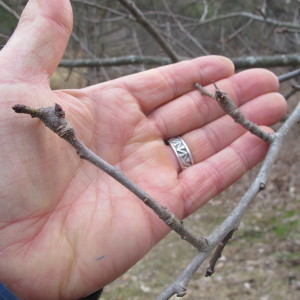Flowers Fit for a Much Loved Dog
Daphne mezereum was the registered name of my corgi, Daffy, who passed away on August 25 of this year. Born in 2006, Daffy was my constant companion who was always ready for an adventure – or especially, a meal or snack. When her back legs gave out, she figured out ways to propel herself forward with glee – ignoring the inconvenience, and trying to overcome the pain. Finally, when the pain was nearly constant, and we reluctantly called the vet.
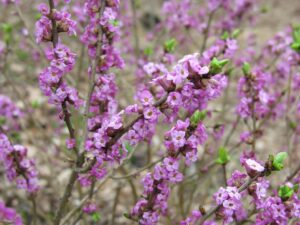 Of course I cut branches of her namesake, Daphne mezereum or February Daphne. It is a fabulous shrub that blooms in May here in Cornish Flat, displaying pinky-purple fragrant flowers in abundance. It is slow-growing, so easy to maintain. No need to do much pruning – other than stems I cut to force in a vase each year in April.
Of course I cut branches of her namesake, Daphne mezereum or February Daphne. It is a fabulous shrub that blooms in May here in Cornish Flat, displaying pinky-purple fragrant flowers in abundance. It is slow-growing, so easy to maintain. No need to do much pruning – other than stems I cut to force in a vase each year in April.I cut fresh perennial flowers for Daphne’s grave, too. Phlox have been gorgeous this year, disease-free and fragrant. Daffy is the only dog I’ve had who noticed flowers. I have a picture of her checking out a vase of tulips. But phlox is in all its glory in sunny beds, so I cut some.
Then we added some Shasta daisies, those wonderful, cheerful flowers with white petals around a central yellow button. My patch of those gets a bit bigger each year in full sun. And Mexican sunflowers (Tithonia rotundifolia), a 6-foot tall orange annual in the daisy or sunflower family. We start lots of these by seed each year, and I am always delighted by the results.
Early Spring Chores in the Garden
With sunny warm days upon us, we all want to start gardening. But beware: if you leave footprints in the soil, or feel it go squish, it’s not time to be doing anything. Plants get their oxygen from their roots, not their leaves. If you compact the soil, you can seriously harm your plants by damaging soil texture and tilth.
Even your lawn is susceptible to compaction. If you must go across it, don’t hurry across it and keep your feet flat, to maximize the surface area of your shoes. And don’t follow the same path each time you cross the lawn. Game trails in the forest can be created by animals as small as house cats if they follow the same path each time they go visit the neighbors. Compaction kills plants.
Raking the lawn seems like a good activity now, but again, depending on where you live, your lawn might not be ready for you. Wait until the lawn has “greened up”. If you rake a dormant lawn vigorously, it is easy to pull up plants, roots and all.
The plow guys dump a lot of sand and gravel on my lawn. I can clean it up now because I can stand in the road and rake it towards me without compacting the soil. I like to use a lawn rake with bamboo or plastic tines for that job, to be gentler on the lawn. Metal lawn rakes are great, but not at this time of year.
If your lawn feels fairly dry and you don’t leave foot prints, perhaps you can get to your flower beds to do a little spring cleanup. I don’t generally rake leaves out of my flower beds in the fall, as I like the extra protection against erosion and cold temperatures they provide. But that means that bulb plants are covered now, and the ground is insulated from the spring sun. I want the soil to warm up.
So I try to clean up places where I know there are spring bulbs as early as possible. If the daffodils are poking through, I use my fingers to pull back the leaves. I fear that a rake will damage the tender stems and flower buds. In other places where bulbs are not up yet, I use a rake and gently rake off the leaves. Sometimes I will bring along a scrap of plywood or a 6-inch plank to stand on as I work, minimizing compaction.
What else can you do? I’ve been cutting branches from early spring-blooming shrubs. This is one of my favorite spring tasks. I’ve had forsythia blooming in the house for over a week now. As an early bloomer, it doesn’t take long in a vase to get blossoms. Select stems that have fat buds and put them in a sunny window until they open. Then move them to a cooler place to prolong the show.
Another spring favorite of mine is called February Daphne (Daphne mezereum). I suppose it blooms somewhere in February – Virginia, perhaps. Here it generally blooms for me in late April, but in 2012 it bloomed in late March. The blossoms are bright pink-magenta, and are fragrant. I like it so much that I named my corgi after this shrub.
I’ve had my February Daphne for 15 years or more and is still a nice compact shrub about 4 feet tall and wide. It is originally from Japan, and I watched it closely when I first got it, as I was worried it might be invasive. I had seen it growing wild on the roadside, so worried it might take over the understory. Nope. I have never seen a single offspring elsewhere on my land.
Pussy willows are opening in the swamps, and I shall go out with my “cut-and-hold” pole pruner to get some soon. This pruner cuts through a stem, and grabs it at the same time. That is particularly nice when gathering branches in a swamp. The one I have is made by the Wildflower Seed and Tool Company of Napa Valley (https://wildflower-seed.com/)
If you don’t have any pussy willows, you should –especially if you have an area that stays wet or damp most of the year. They are very easy to propagate, particularly in the spring before they leaf out. Just cut 12-inch long stems and push most of each stem into the soil. It will send out roots in the ground and leaves above ground.
If the pussy willows you cut are for display in a vase, you don’t need to add water to the vase. They will stay “frozen in time” seemingly forever. If they haven’t fully opened, put them in water until they are cute and fuzzy, then drain the water.
I recently picked a stem of hobble bush, a native viburnum (V. lantanoides), and put it in a vase where it is blooming beautifully. All viburnums would probably force well. Lilacs are early, but I’ve never found them as dramatic when forced as when I let them develop on the bush.
Last spring chore? Clean out your garden shed or barn. Throw away garden gloves with holes in them. Get some steel wool and light sewing machine oil or WD-40, and get the rust off your tools. Sharpen shovels and pruners. Summer will be along soon enough. Enjoy the spring before the bugs come along.
Henry can be reached at henry.homeyer@comcast.net or P.O. Box 364, Cornish Flat, NH 03746. Please include a SASE if asking for a reply my mail. Henry is the author of 4 gardening books.
Shrubs with Fragrant Flowers
Some gardeners grow flowers for their beauty in the garden. Others for their magnificence in a vase. A few select species largely for their scent. My friend Nelia Sargent of Claremont is in this third category, largely because she is blind. I called her recently to see what flowering shrubs she likes best.
Nelia loves shrubs because they pack so many flowers in a small space. And, unlike most perennial flowers, they have their blossoms close to nose level. Who needs to bend over to sniff a peony if you have old fashioned shrub roses standing up 3 or 4 feet tall? Here are some of her favorites along with a few of mine –roughly in sequence of their blossoms.
First for her, in late March or early April, is a witchhazel hybrid (Hamamelis x intermedia) called ‘Arnold’s Promise’. This flowers heavily with yellow strap-like petals an inch long originating at a reddish calyx cup. Although this bush can get large – up to 20 feet tall and wide, I have never seen one half that size, here in the North Country. I have our native witchhazel which blooms in late fall, but this hybrid is a great plant and one I should get. It’s very fragrant.
At the same time (or soon thereafter) is February Daphne, a tidy pink shrub that is very highly fragrant. I love this one so much I named my corgi after it. I’ve had mine for a dozen years and never had to prune it, which is a plus. I’ve seen it growing wild by the side of the road, which makes me wonder if it will be invasive sometime in the next 50 years. But since I’ve not gotten one seedling and it grows slowly, I’m not too worried.
Nelia Sargent then listed a number of viburnums that are fragrant and lovely. Three that she mentioned are Viburnum juddii, V. carlessii, and V. burkwoodii. Don’t be put off by the Latin names. Just pronounce the species names like juddii with an E-I sound at the end. All three species were named after horticulturists.
Viburnum juddii gets to be 6 to 8 feet tall tall, with blossoms about 3 inches across. V. carlessii, also called Koreanspice viburnum, gets to be 4 to 5 feet tall and wide, with 2 to 3 inch semi-snowball flowers. The Burkwood viburnum can get 8 to 10 feet tall with spread about 2/3’s its height; like the others, its flowers are pink in bud, opening to white and highly fragrant.
In recent years there has been an invasive beetle that has terrorized many viburnum owners. Cornell University has listed viburnums according to their susceptibility. Burkwood viburnum was listed as moderately susceptible to defoliation, but V. carlessiiand V. juddii were in the group least attractive to the beetle. You can see the entire list at http://www.hort.cornell.edu/
After the viburnums bloom, and overlapping with them, are the lilacs. Nelia Sargent noted that there are early, mid-season and late lilacs, so one can have fragrant lilacs for at least 5 weeks. First for her comes one called Sister Justina, a white one that stays tidy and does not send up root suckers. ‘Gertrude Lesley’, a double white is also early and nicely fragrant. The common lilac,Syringa vulgaris, has 800 or 900 named varieties. Most are mid-season and nicely fragrant. These spread by root, sending up suckers that will create a hedge if you are not attentive.
Fragrant late season lilacs include Miss Kim (a cultivar of Syringa patula), a slow-growing variety that is (mistakenly) sometimes called a miniature. Mine is now over 8 feet tall, definitely not a dwarf! Another late beauty is ‘Donald Wyman’ (Syringa x prestoniae ‘Donald Wyman’) which is hardy to Zone 2 (minus 50 Fahrenheit) and will thrive despite pollution and compaction in wet or dry soils! One tough plant.
The final shrub on Nelia’s list is mockorange (Philadelphus coronarius). Not related to oranges, this 10 to 12 foot shrub has white blossoms that are sweetly fragrant. That said, be advised that not all cultivars are fragrant, so buy one in bloom. It is an old fashioned flower and not particular to soil type.
Roses can be lovely and fragrant, but many of the modern hybrids have little or no scent. The Knockout roses are fabulous disease-resistant roses that bloom most of the summer, but I’ve only encountered one that was fragrant. On the other hand, rugosa roses are highly fragrant, as are many of the old fashioned roses. I recommend buying them when in bloom if fragrance is important.
I agree with Nelia Sargent: shrubs with fragrant blossoms are a good addition to the landscape. And they are often great for our native pollinators, too.
Read Henry’s garden blog at https://dailyuv.com/
Forcing Shrubs to Bloom – Now!
I don’t know about you, but I am more than ready for spring blossoms. My little bulbs like snowdrops are blooming already, but I want my magnolia, crabapples, forsythia and daphne to bloom, too. Fortunately, I can easily speed up the process –indoors. Here’s what I’m doing.
I have cut branches with flower buds and brought them inside to force them in a vase of water. It’s important to know what to look for when you cut branches to force.
Let’s start with apples. What you need to cut are older branches with little stubby outgrowths on them. Those stubs are called fruit spurs, and if they are at least 2 years old, they should produce flowers and as well as leaves. Most apple trees also create pencil-thin straight new shoots each year. These are called water sprouts and will not produce blossoms in a vase, only leaves. Sometimes I pick water sprouts, too, as even leaves are pleasant in early spring.
Fruit spurs most often are produced on branches that are growing at a 30 to 45 degree angle to the trunk or a main branch. Some young trees tend to be very vertical, sending most branches virtually straight up. If you bend a vertical branch to a broader angle, it will often develop fruit spurs in a year or two. Just tie it in place from now until early June and it should stay at the new angle.
An apple fruit spur produces not one flower, but a few, and leaves, too. Just put the branches in a vase of water in a sunny window. In a week or more the branches will burst open with blossoms. When I prune fruit trees, including apples, crabapples and pears, I regard the branches carefully and pick those most loaded with fruit spurs to bring into the house.
Some 20 years ago I planted a small magnolia in my back yard in the middle of an open lawn. Over the years it has reached full size – perhaps 25 feet tall and nearly as wide – and it blooms reliably on my birthday in late April. I have already cut some branches and put them in a vase, and they will bloom indoors within a week or so.
My magnolia is a ‘Merrill’ hybrid. It is a perfect 4-season plant. In the spring mine has more than a thousand 4-inch, lightly fragrant blossoms. In the summer it has glossy green leaves, and no pests. In the fall it displays colorful seeds and bright yellow foliage. In the winter the buds that will open in spring look like pussy
willows on steroids. And it is growing in moist soil near a stream, a location where many trees would not thrive (many do not like wet feet) . Other than the ancient, stately maples on my property, it is my favorite tree.
Then there is the forsythia, one of the earlier things to bloom in our part of the world. For decades gardeners in northern New England grew old fashioned varieties of forsythia and got blossoms low on the bushes, but not above the snow line. Flower buds on any early-blooming shrub are formed the summer before, and must survive the cold temperatures and winds of winter. Those forsythia buds were not hardy in my zone.
But all that has changed. There are now varieties that are fully hardy in Zone 4 – where temperatures drop to minus 30 degrees Fahrenheit each winter. Prime among them are New Hampshire Gold (developed in my home town of Cornish, NH by the late Paul Joy), Vermont Sun, Meadowlark and Northern Gold. These bloom everywhere. When cutting stems for blossoms, pick vigorous young stems. By now you should see some hints of gold in the buds on those branches.
I‘ve been growing a tidy shrub called February Daphne for a dozen years or so. Its proper botanical name is Daphne mezereum. I love this plant so much that when I got a corgi puppy 10 years ago, my first AKC registered dog, I named her Daphne Mezereum. Of course I call my wonderful dog Daffy (except when she rolls in nasty stuff, when I may use her full name to reprimand her).
February Daphne may bloom somewhere in February – New Jersey, the garden state, for example – but for me it blooms in April. Early April if the weather is mild, like this year. I picked some recently and the buds, nearly open, popped open almost immediately.
The rule of thumb is this: the closer you are to the outdoor bloom date, the quicker a branch will bloom in the house. Lilac, which is still many weeks from blooming for me, will not quickly or easily force in the house now. A week before those buds open? Piece of cake.
On another topic, an important one for gardeners, is the presence of deer ticks in the garden. I recently researched deer ticks and the diseases they carry, including Lyme disease. Ticks are already out and biting. If you wish to go on-line, you can see my piece that gives 7 ways to prevent Lyme disease, along with photos of the ticks. Just go to https://dailyuv.com/
Henry is a UNH Master Gardener and the author of 4 gardening books. He lives and gardens in Cornish Flat, NH. His web site is www.Gardening-Guy.com.




